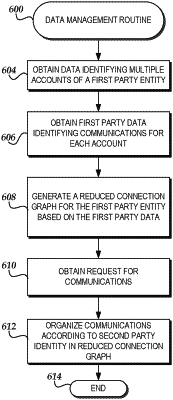| CPC G06F 16/9024 (2019.01) [G06N 3/088 (2013.01)] | 22 Claims |

|
1. A computer-implemented method for organizing data according to detected identities representing aggregate accounts across multiple communication services, the computer-implemented method comprising:
obtaining data identifying multiple accounts of a first party entity, each account of the multiple accounts corresponding to a communication service of a plurality of communication services;
obtaining first party data comprising, for each account the multiple accounts of the first party entity, communication data from the communication service corresponding to the account of the first party entity, wherein the communication data for each account identifies a set of communications, each communication of the set of communication representing an interaction between the first party entity and an additional account on the communication service;
generating a connection graph for the first party entity based on the first party data, wherein the connection graph associates the first party entity with a plurality of additional accounts represented within the first party data, wherein the connection graph includes a plurality of nodes, each node representing an account of the plurality of additional accounts;
generating a reduced connection graph for the first party entity, the reduced connection graph aggregating at least two additional accounts of the plurality of additional accounts into a second party identity based on a comparison of communications, within the first party data, between the first party entity and a first account of the least two accounts and interactions, within the first party data, between the first party entity and a second account of the least two accounts;
obtaining a request from a client computing device of the first party entity for communications of a second party identified by the second party identity; and
presenting, from the first party data, communications between the first party entity and individual accounts of the at least two accounts combined into the second party identity.
|